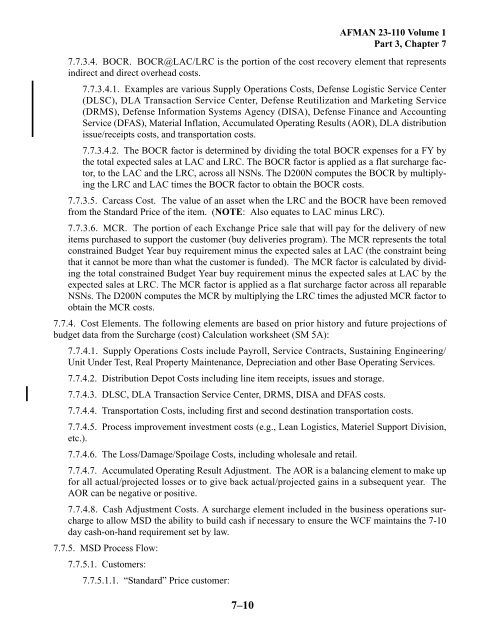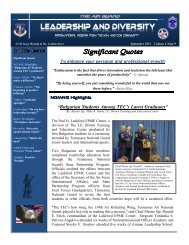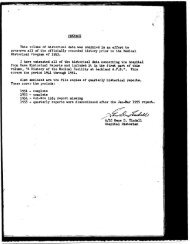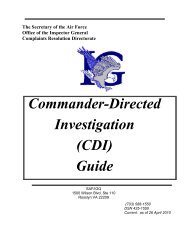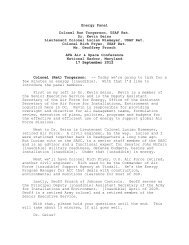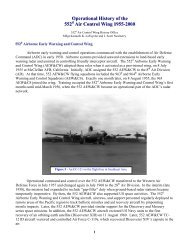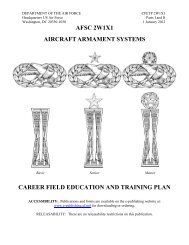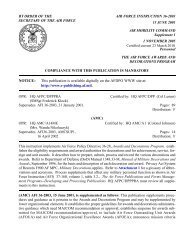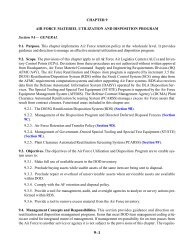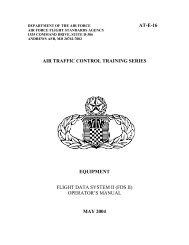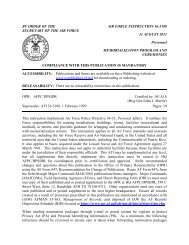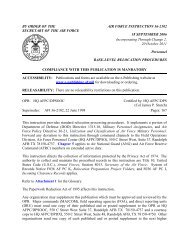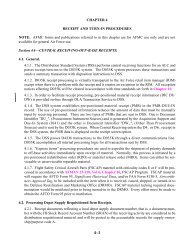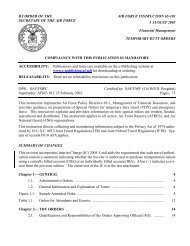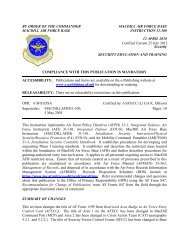Material support division, working capital fund - Air Force Link
Material support division, working capital fund - Air Force Link
Material support division, working capital fund - Air Force Link
Create successful ePaper yourself
Turn your PDF publications into a flip-book with our unique Google optimized e-Paper software.
7–10<br />
AFMAN 23-110 Volume 1<br />
Part 3, Chapter 7<br />
7.7.3.4. BOCR. BOCR@LAC/LRC is the portion of the cost recovery element that represents<br />
indirect and direct overhead costs.<br />
7.7.3.4.1. Examples are various Supply Operations Costs, Defense Logistic Service Center<br />
(DLSC), DLA Transaction Service Center, Defense Reutilization and Marketing Service<br />
(DRMS), Defense Information Systems Agency (DISA), Defense Finance and Accounting<br />
Service (DFAS), <strong>Material</strong> Inflation, Accumulated Operating Results (AOR), DLA distribution<br />
issue/receipts costs, and transportation costs.<br />
7.7.3.4.2. The BOCR factor is determined by dividing the total BOCR expenses for a FY by<br />
the total expected sales at LAC and LRC. The BOCR factor is applied as a flat surcharge factor,<br />
to the LAC and the LRC, across all NSNs. The D200N computes the BOCR by multiplying<br />
the LRC and LAC times the BOCR factor to obtain the BOCR costs.<br />
7.7.3.5. Carcass Cost. The value of an asset when the LRC and the BOCR have been removed<br />
from the Standard Price of the item. (NOTE: Also equates to LAC minus LRC).<br />
7.7.3.6. MCR. The portion of each Exchange Price sale that will pay for the delivery of new<br />
items purchased to <strong>support</strong> the customer (buy deliveries program). The MCR represents the total<br />
constrained Budget Year buy requirement minus the expected sales at LAC (the constraint being<br />
that it cannot be more than what the customer is <strong>fund</strong>ed). The MCR factor is calculated by dividing<br />
the total constrained Budget Year buy requirement minus the expected sales at LAC by the<br />
expected sales at LRC. The MCR factor is applied as a flat surcharge factor across all reparable<br />
NSNs. The D200N computes the MCR by multiplying the LRC times the adjusted MCR factor to<br />
obtain the MCR costs.<br />
7.7.4. Cost Elements. The following elements are based on prior history and future projections of<br />
budget data from the Surcharge (cost) Calculation worksheet (SM 5A):<br />
7.7.4.1. Supply Operations Costs include Payroll, Service Contracts, Sustaining Engineering/<br />
Unit Under Test, Real Property Maintenance, Depreciation and other Base Operating Services.<br />
7.7.4.2. Distribution Depot Costs including line item receipts, issues and storage.<br />
7.7.4.3. DLSC, DLA Transaction Service Center, DRMS, DISA and DFAS costs.<br />
7.7.4.4. Transportation Costs, including first and second destination transportation costs.<br />
7.7.4.5. Process improvement investment costs (e.g., Lean Logistics, Materiel Support Division,<br />
etc.).<br />
7.7.4.6. The Loss/Damage/Spoilage Costs, including wholesale and retail.<br />
7.7.4.7. Accumulated Operating Result Adjustment. The AOR is a balancing element to make up<br />
for all actual/projected losses or to give back actual/projected gains in a subsequent year. The<br />
AOR can be negative or positive.<br />
7.7.4.8. Cash Adjustment Costs. A surcharge element included in the business operations surcharge<br />
to allow MSD the ability to build cash if necessary to ensure the WCF maintains the 7-10<br />
day cash-on-hand requirement set by law.<br />
7.7.5. MSD Process Flow:<br />
7.7.5.1. Customers:<br />
7.7.5.1.1. “Standard” Price customer:


